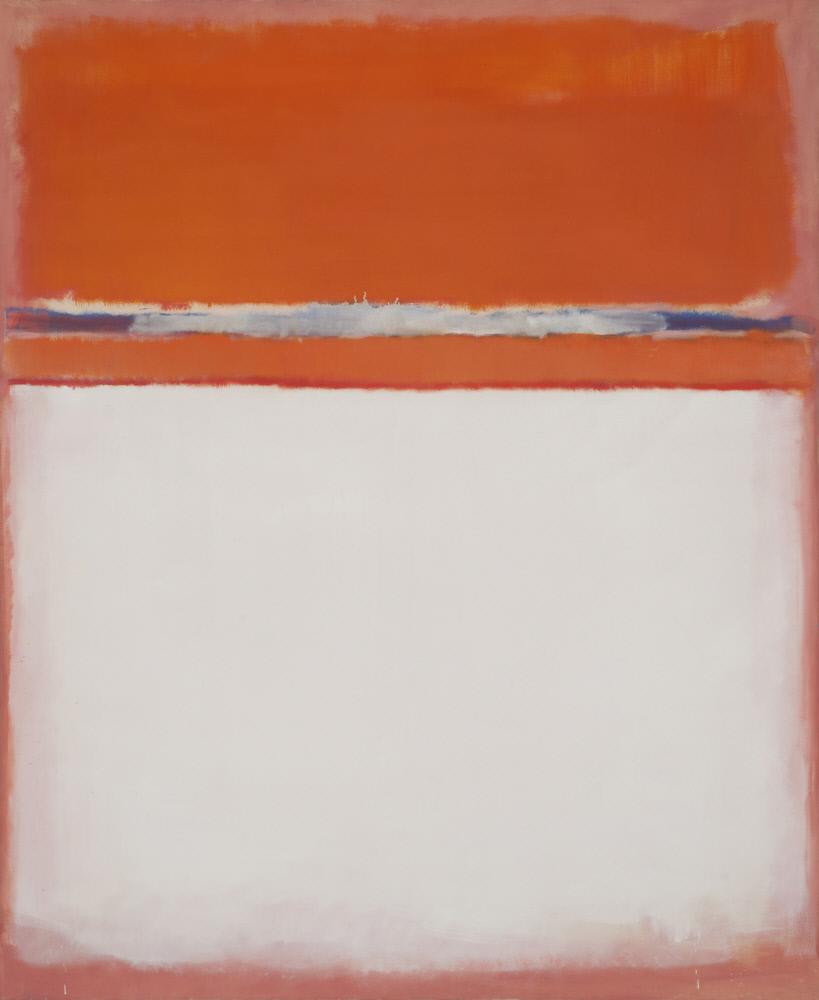Rothko & Pollock – Sunny Chen ’20
Mark Rothko’s Number 18 (1951) creates space and emotion through sections of color. The piece is 81 ¾ x 69 inches and features an orange rectangular shape at the top, segmented by a strip of white and purple tones. Below that is a large white rectangle that fills the majority of the painting, and a cloudy, red-orange border surrounds these shapes. The shapes are horizontal, but the vertical orientation of the canvas gives the piece balance. There are vast amounts of space within the painting; the big, smooth fields of color create an endless depth. Gazing upon the large canvas and standing very close to it gives the feeling of being enveloped by color and by the painting’s warm mood. The large white shape gives the painting a light, lofty sensation. It is almost floating, creating a sense of spirituality. Rothko’s piece can be looked at for a long period of time, and the forms may shift or blend together as the viewer’s body enters the illusionary space of the painting.
Jackson Pollock’s Number 2, 1949 displays emotion through movement. The piece reaches almost 16 feet in length (and about 3 feet in height), and features black, white, yellow, and red paint dripped and swirled across the maroon canvas. The white paint against the dark canvas creates a stark contrast, catching the viewer’s eye. However, as one takes a closer look they can see the other colors and layers. Pollock’s piece conveys a sense of physical movement, emphasized by the length of the canvas. When looking at the painting up close, viewers must move from side to side to see the entire piece. They can almost picture Pollock standing over the canvas, walking and moving across it to create the painting. This process is a direct confrontation of the flatness of the picture plane, as the paint lands where it lands on the surface. The canvas is unprimed, evident in the areas where paint has soaked through and bled out, further emphasizing the material and surface of the painting. Pollock’s energy and emotion is captured through the way the paint is placed on the canvas.
While Pollock’s piece has an emphasis on physical movement as a form of expression, Rothko’s painting conveys a state of being through color and shape. The hand of the artist is not as visible in Rothko’s Number 18 as Pollock’s mark-making. This allows the emphasis to be put on the emotions derived from color and space. Pollock’s piece may appear chaotic and scattered, but there is a level of control in the movement that conveys a calm and free state, similarly to Rothko’s work. Rothko’s and Pollock’s works may impart different aesthetic experiences, but both pieces confront the viewer with deep emotional expression.

Mark Rothko
Number 18, 1951
Oil on canvas
81 3/4 x 69 inches

Jackson Pollock
Number 2, 1949, 1949
Oil, Duco, and aluminum paint on unsized canvas
38 x 189 1/2 inches